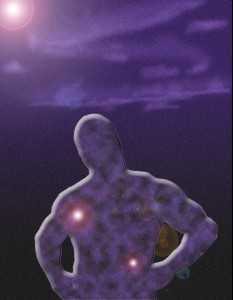This is mark Joseph “young” blog entry #20, on the subject of The Novel Moves Forward.
This is about the creation of my book Verse Three, Chapter One: The First Multiverser Novel, now being posted to the web site in serialized form. This “behind the writings” look definitely contains spoilers, so you might want to read the referenced chapters before reading this look at them. That link will take you to the table of contents for the book; links below (the section headings) will take you to the specific individual chapters, and there are (or will soon be) links on those pages to bring you back hopefully to the same point here. There was also a previous mark Joseph “young” web log post entitled #18: A Novel Comic Milestone, which provided this kind of insight into the first six chapters; this picks up from there.
There is some essential background to the book as a whole in that previous post, which I will not repeat here other than to say that these were the first chapters I wrote directly for use as a novel, not as the script of a comic book.
Quick links to discussions in this page:
Chapter 7, Kondor 3
Chapter 8, Hastings 3
Chapter 9, Slade 3
Chapter 10, Kondor 4
Chapter 11, Hastings 4
Chapter 12, Slade 4
This was the first chapter I wrote directly for use as a novel, not as the script of a comic book.
Having just come off a Slade chapter, I let Kondor make an out-of-place cultural reference to his medical coverage. The characters were still coalescing in my mind, and this seemed an appropriate comment under the circumstances.
It is one of the questions Multiverser raises sometimes for its players: how much can you change and still be human, and does that matter? I wanted to start exploring it here, but I didn’t want to go too far with it. An eye is a small thing, and it would be helpful in future adventures, but I wanted Kondor to think about the long-term consequences of replacing your body parts with machine parts.
Kondor’s reference concerning what he would see is of course recalling Geordi LaForge of Star Trek: The Next Generation, whose views of the world are sometimes given to us as distorted multicolored visions. Kondor’s artificial vision isn’t like that at all, but he could not at this point know what to expect and he would have been familiar with that character, and possibly some others. Geordi is not a cyborg, of course; it’s a mix of concerns from different directions.
I realized even as I wrote the description of the vision control panel that it was going to be difficult to convey the image I had of five half-centimeter diameter wheels with roughened edges jutting perpendicular from his forearm that he would adjust with the fingertips of his opposite hand. I’d seen them on fine tuners on a lot of equipment, but the VCR was the last I’d seen so I went with that.
I was beginning to develop Kondor’s “reverse prejudice” of favoring blacks over whites. I began to see that there was a character development angle in this that I was going to have to address eventually, and so I should keep it in place.
Again we have the “worlds away” phrase this time coupled with “in another life”, both figurative phrases that Kondor means quite literally but knows he can say without much danger of anyone taking him literally.
I had always intended for Kondor to stay with the ship, because the world as I created it really doesn’t go much deeper than the dock areas; but I needed to find a way to induce him to do so, so I had him visit the city.
There are, I think, two kinds of cliffhangers–those which an author creates because he knows what he wants his character to do, and those which he creates because he does not know. This was the former type: I wanted to introduce the idea that Lauren had this telekinetic skill, and having her use it to save Bill was the simplest way to do so. In a sense it makes Bill’s rescue an incidental–which really it is, something Lauren had to do to show the reader she could.
That is, Chekov’s gun over the mantel rule tells us two things. One is what he intends, that if you introduce a detail people are likely to notice, you must use it later in the story. The other, though, is that if you are going to use something later in the story, you must introduce it early when it is not so important.
In that sense, it would have been better for Lauren to use her telekinesis for something simple, like retrieving her coffee mug. However, this cliffhanger was supposed to be the end of a comic book episode, and so to some degree the serious danger Bill faces is an incidental of plot, driving the story forward, and not a major plot point. Bill never plays any significant role after this; I pretty much forgot him.
I should mention that Bill is many people, but that his name comes from one of my players whom we lovingly called The Friendly Giant, and the soft-spoken personality we barely see is also his.
The movie reference is Star Wars V: The Empire Strikes Back, when Yoda suggests that telekinetically lifting a space ship is not harder than telekinetically lifting a pebble.
This is the first time Lauren attempts to make it appear that she has done something difficult but ordinary when she has done something paranormal.
My editor complained that it was foolish to say that Lauren was tired after work, but I could not figure out another way to transition to the fact that she was not going to go to bed because of her forty-eight hour schedule.
I should mention that that editor, Steve Darlington (whom I met online through his position as editor of Places to Go, People to Be), contributed greatly to this work. He sent easily over a thousand comments which I addressed in the rewrite, most of which I have by now lost and forgotten. That I mostly remember those points on which there was tension or disagreement is quite reasonable, since they were the ones that I did not simply fix but actually thought about, but it reflects unfairly poorly on him, as most of what he said was spot on and addressed directly.
The description of focusing faith through objects fits a lot of approaches to the idea without being overly committed to any one of them. It fits the Multiverser concept of supernatural magic working by expectation, but also other views of the matter.
I sometimes joke about “offensive driving” as the counter to “defensive driving”, and I found a place for the joke here, but did not expect laughter.
The idea of using the words of scripture as the focus of faith was something my character developed in-game. I used Koine Greek from the Greek New Testament, but I saw several pitfalls to doing so with Lauren. It would be difficult to deal with the fonts. I would have to translate every time for readers to understand what the words meant. I would be limited to the New Testament unless I acquired a copy of the Septuagint and explained how Lauren got one. So I stayed with English for her.
The statement “Lord I believe. Help my unbelief” is the first time Lauren uses scripture in the way she is thinking of using it–a certain irony, since she does what she wants to have the faith to do.
When I started this chapter, I envisioned a long dungeon crawl with many fights with monsters in the dark. As it developed, I realized that this did not make all that interesting a story–or at least, I lacked the skills to make it so–and I needed to truncate it and get to the goal.
Torelle starts showing a keen intellect, something from which Slade will learn even though he does not yet realize it.
The idea that Slade does not recognize, going this direction, what he originally saw from the other is one that I learned in Scouts, periodically to look behind you on the trail so that if you return this way you will know the look of the land in the opposite direction. Since Slade did not do that, he does not know the look of the tunnels going the opposite way.
I had mentioned the chimney in passing on Slade’s exit, and realized they would have to pass through it on the return, but also that I would have to explain why they had to pass through it. That’s when I invented the collapsed corridor.
I never explained how Omigger knew the time. I later did the same with Shella (in For Better or Verse, which if I live so long and support comes I expect will eventually appear on this site), and have always left it that it’s something wizards can do.
I faced an odd problem in describing a futuristic city: I knew that most predictions of what the world would be like in the future were wrong, partly because they could not predict the right technological advances, but partly because they could not predict the aesthetics of their descendants. Thus I had to give the feeling that this was a futuristic world without decaying to the tropes of the genre. Here I was saved by the fact that this was one of the first stories I was not writing for a comic, so I could describe much of it in the negative, telling the reader what it was not like.
There are half a dozen ports of all on “this side of the loop” before returning to the home port in Sardic, but I had managed to duck describing them all by having Kondor confined to medical for the duration. It was probably an unreasonably long confinement, but it would not have felt so to the reader who was not counting the days and the ports. On the other hand, Kondor needed to make what felt like an informed decision to stay with the ship, and I needed to expand both his military and his medical training to reach some of the vision for this character. A stop in Sardic and the obtaining of the medical texts there would move me in that direction.
I’m reaching back further. The name “Sardic” in the novel comes from the fact that for several years it had been the name used for the home port of the Mary Piper in the game world, published in 1997. That name in turn came from the name “Sardis”, which besides being an ancient city in Turkey was a small town in Mississippi where my father’s family lived, home of Starflight Luggage, if I have my story straight.
It was at this point that I decided Kondor would be teetotal–not exactly so, but as a general principle. In this he is more like me, and for one of the reasons I give, that I don’t like anything to mess with my ability to think. Thus he stays away from alcoholic beverages, starting here, the first time it mattered.
Kondor’s commitment to telling the truth because it was usually easier also began here.
I found the notion of explaining to the aliens that you were abducted by aliens humorous.
I had recently read that women have a preference for purple clothes, but men are more attracted to women wearing red. I decided that this might be something Lauren would know, and so put her in red robes. I always liked red with dark blue best, but red with gold was a close second, and gold trim on a red robe sounded like a good wizardly choice.
I’ve wanted to see The Pit built ever since I designed it in my mind. The idea of a maze under a floor with translucent Plexiglas in places and red light below, enhanced by red spotlights in a random on/off pattern reflecting off white walls to create a feeling of fire (dimmer amber and blue lights might be needed to make the effect realistic, but I didn’t think of that then), mixed with the grill smell of flame grilled meats that some steak places capture along with a high dark ceiling to give the feeling of being at the bottom of an oubliette or similar chasm just has a fascinating atmosphere in my mind, and I have long wondered whether it would work in application.
The Goth movement was still around when I wrote. People really did wear pale foundation and dark lipstick and eyeliner. A Goth club would be a perfect place for undead to hide, and at the same time an unwary Goth might easily be fooled into believing that the undead were others of his ideology.
Lauren’s preference in wine is mine. I never found any alcoholic beverage whose taste I could tolerate until friends served a Martini & Rossi Asti Spumanti at a New Year’s party. I was pleasantly surprised, although I have since been less impressed by it. It is what I buy when I must choose a wine for a celebratory toast.
The line about wine being good for the stomach is of course remembered from I Timothy, and would be something Bible student Lauren would recall.
The idea of an ancient book that Gavin and other vampires wanted was from Ed’s game. I don’t recall the name of the book, but thought Book of Journeys had a good ring to it. Most of the pieces of that story thread came from our interactions in play, although I added some details. I don’t know that it ever mattered to me whether it was actually written by Cain, son of Adam and Eve, or by someone who attributed it to him; it only mattered that it was his name on it and the vampires believed it was his. On the other hand, I believe it is part of the World of Darkness vampire mythology that Cain was the first vampire.
Having Jackson follow Lauren was again part of the cliffhanger technique to keep people reading.
I wanted to put Slade into combat, to begin making him a warrior. I also wanted him to use a bit of magic, the magic of his battle cry that calls on the gods. At the same time, I needed to get the djinni released, and I figured the entire fight was about maneuvering Slade to the place where he could do that.
Having the match flare seemed a nice touch, given that he was battling a creature of elemental fire.
It was a weak point in my mind that Slade chose these particular bottles. My reasoning was that this was the direction Omigger appeared to be going from the guidance of his spell, and when he went this way the efriit tried to stop him, so there was some reason to think this was where the djinni bottle was. On the other hand, I didn’t like to make Slade that sharp that he would draw a conclusion I was not certain would be obvious to the reader, so I wasn’t really comfortable with this. I did have him pull several bottles before finding the right one, as I figured he didn’t know how to tell what bottle it was.
It’s a simple probabilities trick that every time Slade pulls a stopper his odds of getting the right one rises. Given twenty bottles, the chance that the first one is right is only one in twenty, 5%; but the chance that the second is right is one in nineteen, about 5 1/4%, and by the time he’s gotten to the sixth bottle he’s looking at one in fifteen, 6 2/3%. Seen in the broader view, though, if he starts with twenty bottles and opens six, not including the fact that he opens them in sequence, there’s a 30% chance that the right bottle is one of those. So I figured that was a good enough chance that a generally lucky guy could hit it when needed.
There was interest in the first “behind the writings” page, and if it appears again for this one I’ll produce another after a few more pages of the novel have been published to the web site. (The problem of coming up with unique images for each such post, so that PInterest will accept the new page as a new image, will continue to get more challenging, but so far I’ve managed.) Feedback is always welcome, of course.
[contact-form subject='[mark Joseph %26quot;young%26quot;’][contact-field label=’Name’ type=’name’ required=’1’/][contact-field label=’Email’ type=’email’ required=’1’/][contact-field label=’Website’ type=’url’/][contact-field label=’Comment: Note that this form will contact the author by e-mail; to post comments to the article, see below.’ type=’textarea’ required=’1’/][/contact-form]






